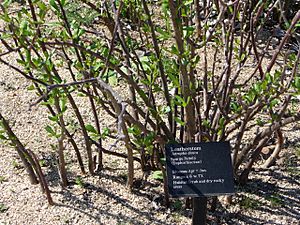Leatherstem facts for kids
Quick facts for kids Leatherstem |
|
|---|---|
 |
|
| Scientific classification | |
| Genus: |
Jatropha
|
| Species: |
dioica
|
| Varieties | |
|
J. d. var. dioica |
|
| Synonyms | |
|
Jatropha spathulata (Ortega) Müll.Arg. |
|
Jatropha dioica is a cool plant that belongs to the spurge family. It's often called leatherstem because its stems are super tough and flexible, like leather! Another common name is sangre de drago, which means "dragon's blood" in Spanish. This plant grows naturally in Texas in the United States and also in Mexico, all the way down to Oaxaca. The name dioica means that the plant has separate male and female flowers, usually on different plants.
Contents
What Does This Plant Look Like?
Jatropha dioica grows in groups, spreading out from underground stems called rhizomes. These are like special roots that help the plant spread.
Stems and Roots
The stems of the leatherstem plant are bendy and succulent, meaning they can store water, just like a cactus. They grow about 20 to 60 centimeters (8 to 24 inches) tall and don't have many branches. They are so strong and flexible that you can even tie them in a knot without them breaking! The roots are orange and can spread out for about 1 meter (3 feet) underground.
Leaves
The leaves grow in different ways: sometimes one by one, sometimes in pairs, or sometimes in small bunches on short shoots from the stems. They don't have long stalks. The leaves of the main type of Jatropha dioica are long and thin, up to 6 cm (2.4 inches) long and 1 cm (0.4 inches) wide. Another type, J. dioica var. graminea, has leaves that might be split into 2 or 3 parts and are a bit longer and narrower.
Flowers and Fruit
This plant has small flowers that bloom in spring and early summer. Male flowers grow in clusters and have small green parts (sepals) and white petals. They also have 10 stamens, which are the parts that make pollen. Female flowers are shaped like a pot and have petals that curve back at the tips. After the flowers, the plant produces a small fruit, which is a capsule about 5 mm by 12 mm. Inside, there are usually 1 or 2 round seeds, each about 1 cm (0.4 inches) big.
What's Inside the Plant?
Jatropha dioica produces a special sap called latex. This sap is made in a network of cells inside the plant. When the clear-yellow sap touches the air, it quickly changes to a blood-red color! This is why it's called sangre de drago, or "dragon's blood."
Special Chemicals
The roots of this plant contain a chemical called riolozatrione. This chemical is a diterpene, which is a type of natural compound. It has properties that can help fight tiny germs, like bacteria.
Plant Safety
While the plant has interesting properties, it's important to know that eating it can make animals sick. For example, if sheep or goats eat leatherstem, they might get an upset stomach. The plant can also safely soak up a lot of zinc from the soil.
Where Does it Grow?
The main type of Jatropha dioica grows in southern and western Texas in the United States. It's also found in parts of Mexico, including Tamaulipas, Nuevo León, and all the way down to Oaxaca. The other type, J. dioica var. graminea, grows from Chihuahua to Zacatecas in Mexico, and also in the Trans-Pecos region of Texas. The first sample of this plant was found in Jimulco, Coahuila, Mexico.
How People Use It
People have used Jatropha dioica for a long time in traditional medicine.
Traditional Medicine
It's often used to help with dental problems like gingivitis (gum inflammation), loose teeth, bleeding gums, and toothaches. The red latex from the plant is an astringent, which means it can help tighten tissues and stop small bleeds.
Other Uses
The red latex can also be used as a natural red dye. Sometimes, people grow leatherstem in their gardens as an ornamental plant. It's especially popular in xeriscapes (gardens that need very little water) or rock gardens because it's tough and doesn't need much care.
Plant Neighbors and Friends
Sangre de drago acts like a "nurse plant" for small cacti, including types of Lophophora. This means it provides shade and protection for these smaller plants as they grow. The seeds of the leatherstem plant are also a food source for white-winged doves.

